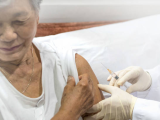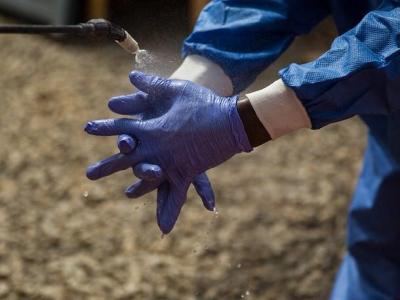Dec 14, 2006 (CIDRAP News) – Two studies reported in today's issue of the New England Journal of Medicine provide additional support for seasonal influenza immunization while shedding some light on questions about vaccination strategies and the efficacy of the vaccines.
Both studies were conducted in the 2004-05 flu season, when the vaccine was not optimally matched to the circulating virus strains. One study suggested that school-based flu vaccination programs in four states reduced flu-like illnesses in schoolchildren's households. The other indicated that inactivated flu vaccine showed good effectiveness in adults despite the imperfect match with circulating viruses.
Multistate school-based study
In the school-based study, researchers grouped 28 elementary schools from 4 states into 11 demographically similar clusters, each of which included one intervention school that offered the vaccine plus 1or 2 schools that served as controls.
In the intervention schools the intranasal formulation of the live attenuated influenza vaccine (FluMist) was offered free of charge at school to all healthy children age 5 or older during the fall of 2004. The study was supported by MedImmune, maker of FluMist.
Researchers sent questionnaires to the intervention and control groups' homes after the predicted week of peak flu activity for each state, asking families about flu-like symptoms, medical visits, medications, and absences from school and work.
At the intervention schools, 2,717 (47%) of 5,840 students received the vaccine. Ninety-five percent of 1,535 children who were eligible to receive a second dose received it. The average age of the vaccinated students was 7.9 years (range, 5 to 14).
Researchers predicted the peak influenza week correctly at two sites and were within 2 to 4 weeks at the remaining sites.
The results revealed that intervention-school households reported fewer flu-like symptoms during the peak illness week than control-school households. The use of medications and humidifiers was lower in the intervention households.
The number of visits to doctors or medical clinics was also lower, but the two groups did not differ in the rate of emergency department visits. Hospitalization rates in the intervention-school households were significantly higher, however.
School absenteeism rates in the peak flu activity week were significantly lower for elementary and high school students in the intervention schools, though not for middle school students. At intervention schools, unvaccinated students had higher absenteeism rates than their vaccinated counterparts. Also, parents of children in the intervention schools reported fewer work days missed because of flu-like illness.
Safety results in this study were consistent with previous results with the live attenuated vaccine, the authors noted. Four serious events were noted in four students within 42 days after receiving the vaccine. Only one was judged to be possibly related to the vaccine. None of the students were hospitalized, and all events resolved completely.
The authors concluded that the study shows the benefits of a population intervention. "Even though fewer than half of the children were vaccinated, important benefits were observed," they write.
Kristine Moore, MD, MPH, a coauthor of the study, said, "We've known from a number of studies that children are one of the main amplifiers for influenza." She said the study shows that vaccinating children in schools can dampen the amplification process by reducing flu-like illness in their households.
The researchers found that the intranasal vaccine was simple to administer in the schools, said Moore, who is medical director of the University of Minnesota Center for Infectious Disease Research and Policy, publisher of the CIDRAP Web site. "This wasn't a feasibility study, but it showed that school based vaccination can work," she said.
Moore said the study findings add to ongoing public health discussions about vaccination strategies, which are complex and range from targeting high-risk populations to universal vaccination.
In an accompanying editorial, two flu vaccine experts from the World Health Organization (WHO), Keiji Fukuda and Marie Paule Kieny, comment, "The findings strongly suggest, but do not conclusively demonstrate, that the vaccination of these children reduced the spread of influenza to their households and to other student populations."
Michigan study of vaccine effectiveness
In the second study, authors hoped to answer questions about how current vaccines perform when circulating virus strains differ from the strains used in the vaccine. The study group included 1,247 healthy adult Michigan residents. Participants were randomly assigned to receive the inactivated vaccine or a placebo by intramuscular injection or the live attenuated vaccine or a placebo by intranasal spray between October and December 2004.
Researchers monitored subjects by phone or e-mail until April 2005, instructing them to contact the study staff whenever they had an illness with at least two respiratory or systemic signs or symptoms. Throat swabs were collected from participants during the surveillance period to identify flu cases and define the period of flu activity. Serum samples of patients with symptoms were also collected and tested against the circulating viruses. Flu cases were identified by three methods: cell culture, polymerase chain reaction (PCR), and serologic (antibody) studies.
As the flu season progressed, researchers found that the type A(H3N2) virus had drifted from the strain included in seasonal vaccines and that an unanticipated strain of type B virus was circulating, in addition to the one included in the vaccines.
The authors found that the absolute efficacy of the inactivated vaccine against both types of virus was 77% on the basis of cell-culture confirmation of cases, 75% on the basis of cell culture or real-time PCR case confirmation, and 67% with cell-culture or serologic confirmation of cases. Using the same assessment measures, the absolute efficacy values for the live attenuated vaccine were 57%, 48%, and 30%, respectively.
The researchers say the efficacy differences between the two vaccines appeared to be related to reduced effectiveness of the live attenuated vaccine against type B viruses.
Four serious adverse events occurred among the participants within 30 days of receiving the virus, but only one was considered possibly linked to the vaccine.
The performance of the inactivated vaccine was surprising, the researchers write. "This result was somewhat unexpected, given problems reported in past years when antigenically drifted viruses were circulating," they state, adding that the consistent results of all of the confirmation methods were reassuring.
Also unexpected were the indications of reduced efficacy of the live attenuated vaccine, they write, because previous studies showed it to be effective in years when drifted strains circulated.
Using antibody titers to confirm infection with influenza may overestimate the efficacy of the inactivated vaccine and underestimate the efficacy of the live attenuated vaccine, the authors propose. They observe that live attenuated vaccines have shown efficacy in children, even against drifted strains, but in adults the live vaccine may not provoke an adequate response because of past influenza infections.
Even if the intranasal vaccine is less effective in adults, the authors write that it would still be useful as the United States moves toward universal vaccination strategies.
"The live attenuated vaccine could also be useful in a pandemic, given that the population would have no preexisting antibodies for the virus, and one dose of the vaccine would be expected to protect against it," they write.
Fukuda and Kieny, in their editorial, say the findings indicate that the two types of vaccines confer similar protection against influenza A in healthy adults, but more research is needed to determine if the vaccines are similarly effective in other age-groups and to assess the effectiveness of the live vaccine against influenza B.
The WHO experts note that some observers question whether the substantial efforts to produce and deliver flu vaccine each year are justified. "The answer is, unambiguously, yes," they write. "Indeed, the critical public health question is not whether influenza vaccines should be used, but how they can be used to advantage."
King JC, Stoddard JJ, Gaglani MJ, et al. Effectiveness of school-based influenza vaccination. N Engl J Med 2006;355(24):2523-32 [Full text]
Ohmit SE, Victor JC, Rotthoff JR, et al. Prevention of antigenically drifted influenza by inactivated and live attenuated vaccines. N Engl J Med 2006;355(24):2513-22 [Full text]
Fukuda K, Kieny MP. Different approaches to influenza vaccination. (Editorial) N Engl J Med 2006;355(24):2586-7 [Full text]














